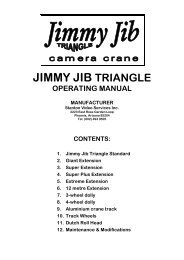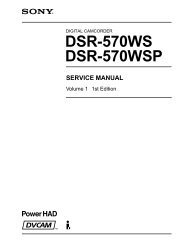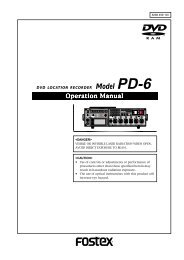GM-TTT - Alpermann+Velte
GM-TTT - Alpermann+Velte
GM-TTT - Alpermann+Velte
You also want an ePaper? Increase the reach of your titles
YUMPU automatically turns print PDFs into web optimized ePapers that Google loves.
Installation & Operation Manual <strong>GM</strong>-<strong>TTT</strong><br />
3.2.5 USER MOD.: Data Content of the Binary Groups<br />
Page 31<br />
Press the enter button to define the data content of the binary groups. The current selection<br />
appears at the display. Use the ↑ or ↓ button to step through the different items. Press the<br />
enter button to confirm your choice and to quit the menu.<br />
Please notice: in the tc operating mode the data content of the binary groups will be<br />
overwritten, if the Jam-Sync mode includes a transfer of the binary groups.<br />
Digit 8 Digit 7 Digit 6 Digit 5 Digit 4 Digit 3 Digit 2 Digit 1<br />
0 SET The binary groups get user defined data, see 3.2.2 SET USER.<br />
1 <strong>TTT</strong> The binary groups get multiplexed data for use in the MTD Time-Timer-Time Code<br />
System. The specific LTC(MTD) will be generated.<br />
2 DATE The binary groups 1 to 6 get the date of the internal clock, BCD format: day =<br />
groups 5+6 (“minutes“), month = groups 3+4 (“seconds“), year = groups 1+2<br />
(“frames“). The year is coded with two digits. The groups 7+8 (“hours”) get the<br />
user defined data, see 3.2.2 SET USER. Look at the table of the end of this chapter<br />
for a survey of the date formats.<br />
3 STATUS The binary groups 1 to 6 get the date of the internal clock, same as at 2 DATE.<br />
The groups 7+8 (“hours”) contain status information:<br />
Bit(s) Group 7 (“units of hours“):<br />
0 = 1 if the time addresses of the time code output are synchronised to a<br />
reference time, which is locked. This bit is set in operating mode time<br />
only. Within the last 24 hours the internal clock must have received a preset<br />
from a reference time, which is locked itself. The lock status of the<br />
reference time is indicated by status information of the serial data input<br />
and is visibly indicated by the LED free.<br />
1+2 = time zone of the internal clock: bit 2 bit 1<br />
0 0 = UTC<br />
0 1 = CET<br />
1 0 = CEST.<br />
3 = 1 during announcement start/end of Daylight Savings Time, one hour<br />
before the changing occurs.<br />
Bit(s) Group 8 (“tens of hours“):<br />
0 = 1 during announcement of a leap second, one hour before the<br />
changing occurs.<br />
1 Y2K flag: =1, if the two digits coded year is less 98, else it is = 0. See “5<br />
DATE-2” as well.<br />
2 not used, = 0.<br />
3 not used, = 0.<br />
Look at the table of the end of this chapter for a survey of the date formats.










